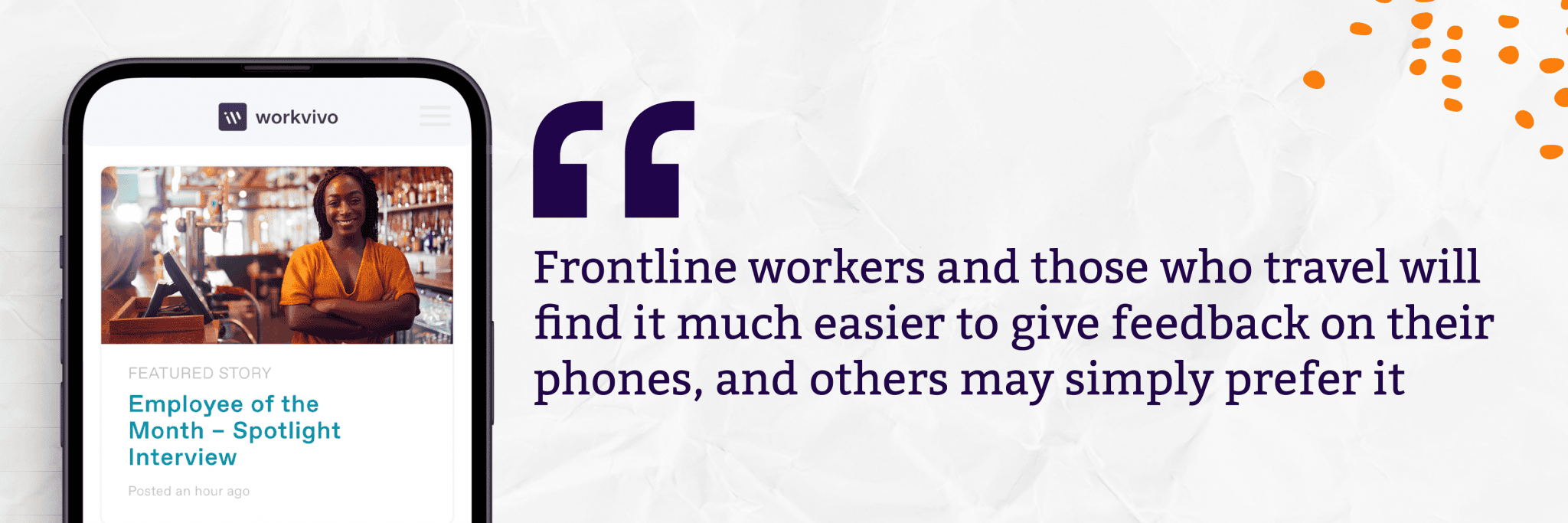What Remote Workers Want – The Ultimate Guide

Lisa Ardill
Content Editor at Workvivo
August 7 2022

Wondering what remote workers want from their employee experience? All you have to do is ask them. We’re here to show you how.
Did you know that the idea of remote working was first formally introduced by a rocket scientist? Back in 1973, Jack Nilles coined the term ‘telecommuting’ and spoke of how it would be good for business and better for the environment.
Nilles’ reasoning was that local satellite offices for workers would lower stress levels, increase productivity, save money, and reduce traffic. Sound familiar?
Almost 40 years later, it’s taken a global health crisis to convince the wider workforce that not only is remote working a perfectly viable option, but one that can deliver in all the ways Nilles had predicted.

During the pandemic, most organizations adapted to the newly online working world through some trial and error. Those that managed to keep their company culture intact in the process – no easy feat, particularly without the right kind of support and tools – listened to what was and wasn’t working for their people.
And as it looks like remote working is here to stay for many of us, that two-way conversation needs to continue. Wondering what it is that your remote employees want? All you have to do is ask them. We’re here to show you how.
The remote worker is here to stay
The number of people working remotely full time more than quadrupled between 2018 and 2021. Even with companies now opening their offices back up, many are opting for a hybrid model and will need to work to keep both in-person and remote employees engaged. 48% of employees will keep working remotely after the pandemic and 47% of employers will allow their staff to do so.

And maintaining culture is top of mind for companies going fully remote or hybrid: 30% agree that it’s their biggest concern. One of the best ways to capture and keep your culture is to build it on what your employees actually want. If your workers value compassion, then you need to nurture a compassionate environment. If you’re transitioning to a hybrid or fully remote model or you have some new hires joining the company remotely, ask for inputs and translate them into tangible actions.
Statistics on workplace trends are certainly useful, but don’t let abstract numbers on a page become your holy grail. Every business is different and their approaches to employee engagement and experience should be too. The most important thing is that you ask your own employees what they need – and then listen to what they’re saying.
And don’t forget that it’s a work in progress – you need to evaluate as you go and regularly check in with staff to ensure you’re getting it right. In this guide, we’ll take a look at some of the ways you can do that.
The challenges of understanding what your remote workers want
What are the biggest barriers to knowing what your remote workers want? One of the problems we see a lot is that people working remotely feel less connected to their colleagues, their leaders, and their company values.
27% of remote workers say they have experienced a work-related problem because they weren’t in the same place as their team, and more challenges arise when your workforce is split between onsite and remote; you need to pay particular attention to avoid an ‘us versus them’ culture developing.
- Disconnect
If your people are feeling disconnected from the company and their colleagues, chances are they’re not particularly excited about your business values or overall goals. Almost half of senior employees believe their company mission makes their teams feel that their jobs are important, but only 37% of the people on those teams agree.
If a person doesn’t feel valued for their work or that they’re making a difference to company objectives, the likelihood of them sharing their thoughts is far lower.

- Us versus them
Disconnection and disengagement can be exacerbated when there are lines drawn between different groups in your company. If there’s a meeting where 70% of your employees are around the same boardroom table and 30% are dialing in, the virtual attendees can be more prone to feeling isolated.
A culture in which people feel they’re not ‘part of the action’ is one that stifles genuine employee feedback. It can also make things harder logistically if you’re asking for some opinions in person and others through online means.
- Showing appreciation and taking action
One of the biggest blockers to finding out what your remote workers want is failing to show appreciation and recognition when they take the time to tell you. What many employers are lacking here is the infrastructure to reassure every individual that their inputs are reaching the leadership team, and the capacity to show those inputs are being translated into actions.
If employees can’t see the route their feedback is traveling, they’ll be much less motivated to provide it in the first place.
- Tech
Using the right technology can do wonders for your relationship with your remote workers. A good internal comms and employee experience platform will also make things easier for your team by keeping all of the information shared by staff in one easy-to-access and user-friendly place. This is especially helpful for the many HR professionals experiencing burnout like never before.
Without the infrastructure to collect feedback from every employee in the same way – whether they’re onsite or remote – you could be edging closer to an ‘us versus them’ culture. And again, it also makes more logistical sense: remote workers are often based in different locations, and adopting technology that supports asynchronous communication is a must.
5 ways to find out what your remote workers really want
The first thing you need to remember is that if you want to know what your remote workers really want, you need to ask them. The second is that you need to listen to what they say.
Employers that use “continual listening” to inform their decisions, according to Oracle, stand to see payoffs across recruitment, retention, engagement, and productivity.
Here are some ways to discover what your remote workers want.
1. Make it easy for them to tell you – and easy for you to review
Your remote workers probably know what they want. And if they don’t, discussing ideas with them is a great way to figure it out together. Either way, your employees are the ones who know what it’s really like to work for you, so it stands to reason that they have a good idea of what needs to change.
One of the biggest differences between remote and traditional in-office working is that asynchronous communication becomes paramount. Companies need reliable methods of receiving information from their staff no matter where they’re based and what timezone they’re in.
Of course, emails can be sent asynchronously – but keeping track of responses from every employee is a tedious and time-consuming process for your internal comms team. A much more efficient and tidier option is employing a tool that every worker can use to submit their feedback.
The right one will be user-friendly for your staff and your internal comms people, making the results easy to review, digest, and implement.
2. Go mobile to give everyone a say
Depending on the industry you’re in, you may have frontline workers, employees who travel regularly, or a mixture of both. Again, keeping communications streamlined means everyone is included and no messages slip through the cracks.
One of the best ways to guarantee this is by making your communications platform mobile-friendly. Frontline workers and those who travel will find it much easier to give feedback on their phones, and others may simply prefer it.
Embracing a feedback tool that’s both desktop and mobile-friendly shows that you want to hear what every single person has to say and means you get far more engagement when you ask for it.

3. Embrace open communication
The goal of finding out what your remote workers want is to improve their employee experience. To truly champion this, you’ll need to leave traditional top-down communication behind and embrace open communication instead.
Open communication is non-hierarchal. It creates space for two-way dialogue between leaders and employees, paving the way for far more meaningful conversations. And meaningful conversations are what you want if it’s honest feedback you’re looking for.
An environment that favors open comms is much more inviting to an employee with feedback to give than one that won’t let go of the top-down model. If a person doesn’t feel that work is a place where they can use their voice, you won’t be hearing from them very much.
4. Seek (and listen to) employee feedback in new ways
Explore the most effective ways to engage your staff in conversations. Introducing new ways for them to talk to you shows you’re making a serious effort to hear what they have to say.
If you’re asking a simple question that requires a simple response, try creating a poll that people can vote on.
If you want to keep conversations around specific themes in the workplace going on a regular basis, set up a weekly Q&A where workers can ask questions and have them answered in real-time.
And if you’re looking for something more creative again, try your hand at podcasting. Everyone loves a podcast, so make them a part of your strategy. You could host episodes on particular themes that staff want to talk about or use them to discuss ideas put forward for the company – the opportunities are endless.
Again, these are all methods that facilitate asynchronous conversations for remote workers. Seek out an internal communication and employee experience platform that incorporates all these features in one accessible place and you’ll never look back.
5. Show appreciation for feedback
Asking for feedback is one thing, but showing that you really want to hear it – and that you’re going to take it seriously – is another. Showing your employees that you value their opinions and experiences is a sure way to build trust in your organization. And this will have a ripple effect; more trust leads to more honest feedback, which makes for a great company culture.
Showing appreciation when people give feedback lets your staff know that you’re listening, and is a good way to incentivize more two-way conversations, which are critical in a healthy company.
So how do you show appreciation? An internal comms and employee experience tool should make this possible through shout-outs that leaders can post to a feed that’s visible to the entire company, commending individuals, teams, or the wider community for their inputs and ideas.

Other platform features that can help here are awards and badges. Making badges available that celebrate sharing feedback and new ideas for the company can be a tangible symbol for employees, and one they strive to achieve.
The must-have features for an internal communications platform
There are many parts to a good communication strategy. It needs to involve carefully crafted, well-branded content. It should also allow your entire workforce to contribute to the conversation, which requires careful planning as well. However, none of that will work if it’s not sitting on a powerful platform that’s designed to bring employees together.
There are many different platforms out there, and they all come with their own unique features — the one you choose will depend on the specific needs of your organization.
However, there are some key features that you shouldn’t compromise on. Here are some of the must-haves to look for when you’re choosing a platform:
- An intuitive and familiar interface
If you want your employees to actually use the platform you choose, you need to make sure it’s easy and inviting. That means looking for solutions with an interface that’s pleasant and easy to navigate. And if your remote workers are frontline or travel frequently for work, they don’t have time to learn the ins and outs of a whole new complicated program.
- A mobile app
If you want to engage your remote workers, you need to meet them where they are – which means looking for solutions that are accessible on a smartphone. More than this, the solution you choose should be mobile-first, not just a website that’s technically accessible on a smartphone if you turn your phone on the side and wait for it to load.

- Push notifications
There are times when you need to get a message out to your entire organization – and know they’ve received it. This is a particular consideration when we’re talking about remote workers, since they might be harder to reach than your office-based employees. To get around this, use an app that has a push notification feature. Then, when you have a really important message to transmit, you’ll know it’s gotten to everyone.
- Pulse surveys and polls
Pulse surveys are a great way to keep an eye on what’s actually going on in your organization in terms of employee engagement. And polls can be used to great effect with remote workers in particular: for example, when you need feedback on a new policy you’re thinking of implementing. Often, things seem like a great idea in head office, and it takes someone on the ground to point out an obvious problem. Any communication platform you choose should make it easy for you to send out these surveys and polls, and for your remote employees to respond to them.
- Opportunities for bottom-up and cross-functional communication
As we’ve discussed, the most effective communication doesn’t come from the top down. To really empower your remote employees, you need a solution that allows them to communicate with each other regardless of location, discuss problems, and even connect on a social level. Bonus points if your platform has social media-like functions like comments and emoji reactions, which all help to make things more fun and engaging.
Introducing Workvivo

Workvivo is an employee communication platform with the power to bring your whole organization together — whether they’re at their desks or out on the road. Our platform helps your employees to communicate, share ideas, and better understand your company’s core mission and values.
Employees from all parts of your organization can post updates, ask questions, and give shout-outs, and they’ll appear to other employees in a personalized news feed. Our employee recognition features can help you to build a culture of real-time, spontaneous peer-to-peer recognition. And you can easily send out polls and surveys that employees can respond to with just a few taps of the screen.
And did we mention? Our platform is fully accessible through our mobile app, which means it’s the perfect tool to engage all of your employees, whether they’re frontline, in transit, or remote.
Want to learn more? Book a personalized demo to understand how Workvivo can help you supercharge your comms with remote employees and set your business up for success.